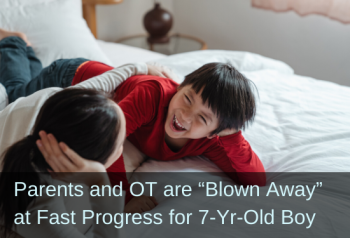Head-Slapping and Thumb-Sucking Stop, While Fine and Gross Motor Skills Improve
Submitted by Natalie Green MOT, OTRL

|
Before
|
After
|
|
Exhibits head-slapping behavior that has not decreased with numerous types of treatments and sensory strategies
|
No longer head-slapping
|
|
Had been working on crab-walk for over a year, and had only been able to go for 30 feet
|
After 4 weeks, can now crab walk for 75 feet without any assistance
|
|
Would suck thumb to self-soothe
|
No longer thumb-sucking
|
|
Simple hand writing tasks would often take a full session to complete
|
Attending to fine motor tasks with better attention and writing with better accuracy
|
Joey is 7 years of age during the time of treatment with reflexes. Joey was the result of a full-term vaginal pregnancy. He has the dx of ASD [Autism Spectrum Disorder]. Some of Joey difficulties include significant decreased coordination, decreased core strength, decreased upper body strength, global hypotonia, nonverbal, poor fine motor skills for writing and other tasks, and dressing dyspraxia. Joey has been coming to our clinic for a handful of years and receives SLP, PT, OT, and ABA services. Joey also has a handful of behaviors, the most concerning behavior is head-slapping. This is a repetitive behavior which has not decreased with numerous types of treatments and sensory strategies.
I began taking this class and immediately started testing all of our patients. I am not the primary OT that treats Joey; however, I work very close to the COTA that treats him 3-4x per week.
I have observed and assisted in all treatments to observe and guide the treatment to assist in integrating the patient’s reflexes. We began with rhythmical movements. [From the Brain and Sensory Foundations course].
After the first session using only rhythmic movements, we instantly noticed a change in his attention to fine motor tasks and his participation towards the tasks. Joey became more alert and was more successful in simple hand writing tasks that usually would take a full session to complete. After a week of completing the rhythmical movements only, Joey was noticed to have significant decrease in head slapping. This was huge as the parents were becoming increasingly concern with the damage that could occur secondary to this.
The second week we continued using the RM at the beginning of the session then we did the isometrics for the TLR forwards and backwards. The patient tolerated well therefore, after two sessions that week, we did the movement activity related for the TLR. [From the Brain and Sensory Foundations course].
The third week we put it all together and completed the 5-step balance process: We focused on the integration of the TLR forwards and backwards.
We started with the rhythmical movements [and completed the 5-Step Balance process from the Brain and Sensory Foundations course]. After this session, his COTA completed the same sequence for the next two sessions. He began to complete his crab walks independently for 50 feet with out verbal cues, tactile cues, or physical assistance. His endurance was dramatically improved. He was able to complete the gross motor tasks much further meeting a lot of his short-term goals were met. He also was attending to his fine motor tasks with better attention and writing with better accuracy.
At week 4, Joey was no longer head slapping. He was able to crab walk for 75 feet without any assistance, a goal we had been working on for over a year and we were only able to complete the crab scoot for 30 ft. Joey was demonstrating improvements with auditory processing in OT and SLP. He also stopped sucking on his thumb as a self-soothing behavior. Joey no longer tested positive for the TLR forwards or the TLR backwards.
I was simply blown away by the progress made in one short month by addressing one reflex. I changed his treatment plan and added in the next reflex to work on integrating. All of my evaluations and re evaluations are now focused on what reflexes are still present and the treatment plans are developed to address these reflexes to assist in meeting the other goals. Joey’s parents were blown away by the simple progress he made in such a short amount of time.
[Edited, emphasis added]


